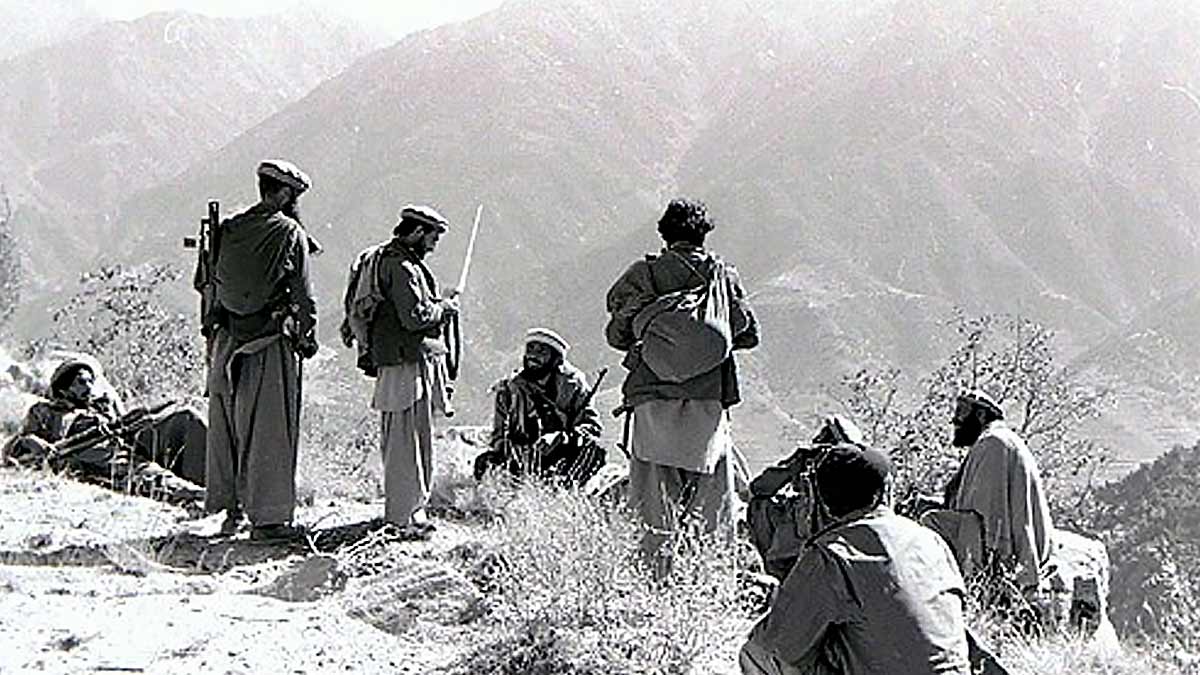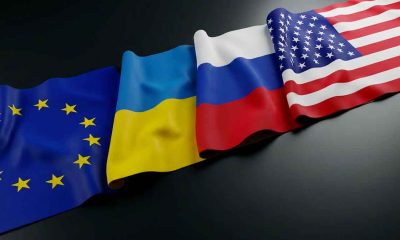National
Part 2: The complex history of Islamic extremism and Russia’s contribution to the rise of Al Qaeda and ISIS
Part two of a ten part series explaining how a series of events starting in 1951 led to the creation of Al Qaeda and ISIS, and their mid-21st century resurgence.

This is part two of a ten-part series that explains the rise of modern Islamic extremism. From 1951 to 2021, a series of key geopolitical events, many independent of each other, caused the Islamic Revolution, the rise of Al Qaeda and ISIS, the creation and collapse of the caliphate, and the reconstitution of ISIS as the ISKP. While Western influence and diplomatic blunders are well documented through this period, the Soviet Union and the Russian Federation are equally culpable. The editors would like to note that a vast majority of the 1.8 billion people who are adherents to some form of Islam are peaceful and reject all forms of religious violence.
Read Part One: The complex history of Islamic extremism and Russia’s contribution to the rise of Al Qaeda and ISIS
Part Two – The Soviet’s coup d’etat and invasion of Afghanistan catches the attention of Osama bin Laden
The Kremlin fears the spread of radical fundamentalist Islam
On December 5, 1978, the Soviet Union and Afghanistan signed a 20-year “friendship treaty.” Moscow saw stable relations with Afghanistan as a key national security issue and had worked to improve bilateral relations since the end of World War II. The agreement included economic and military assistance and was meant to prop up the new government of Nur Muhammed Taraki after a violent coup d’etat.
Just as Western intelligence had failed to detect the coming Iranian Revolution, their Soviet counterparts failed to warn the Kremlin of the April 1978 Suar Revolution in Afghanistan, which overthrew President Sardar Mohammed Daoud. Daoud had come to power in a 1973 coup d’etat and was executed, as were over 2,000 military and government officials.
Hafizullah Amin and Taraki of the People’s Democratic Party of Afghanistan led the brutal takeover and ended the 152-year Barakzai Dynasty. Taraki was named the Chairman of the Council of Ministers, the de facto leader of Afghanistan, and replaced the single-party rule of Daoud with the single-party rule of the Communist Party. Initially, Amin and Taraki were aligned, but in less than a year, their relationship had turned hostile as Taraki made a series of politically and religiously unpopular decisions, and Soviet influence turned into interference.
By March 1979, just two months after the Shah of Iran abdicated, 25 of the 28 Afghanistan states were no longer considered safe. The new government was already unraveling, with Amin tugging at the threads. He maneuvered the Afghan Politburo to name him Prime Minister, eroding Chairman Taraki’s power.
Moscow saw Amin as a threat who leaned toward Pakistan, China, and the United States, with KGB operatives believing he was working with the CIA. As Prime Minister, Amin instituted extreme repression within Afghanistan in an attempt to stem protests and growing antigovernment violence. By July 1979, Soviet-controlled media was publicly declaring their non-support for Amin’s leadership.
Behind closed doors, the Kremlin was unimpressed with Amin and Taraki, believing that neither was capable of maintaining power. Moscow became increasingly worried that the Islamic Revolution in Iran could spread to the Muslim-dominated Caucasus and the southern Soviet republics. Brezhnev’s advisors were trying to convince him that intervention in Afghanistan would be required to prevent a similar revolution from happening in Central Asia and then spreading through Russia.
In June 1979, the first Soviet troops entered Afghanistan at Kabul’s request. The arrival of military equipment, including T-72 tanks and infantry fighting vehicles, occurred in the open, but the Soviet Union took the little green men approach with troops. A battalion of “unarmed” airborne soldiers (VDV) was deployed as “specialists and advisors.” A month later, Kabul asked for two more Soviet divisions, which Moscow ignored.
In the next four months, 160,000 Afghans fled to Pakistan to escape the growing political and religious violence. Despite a strained relationship with the Carter Administration, Pakistani leaders appealed for the U.S. to intervene indirectly by providing support to a growing number of Afghan Islamist rebels. Within the halls of Washington, D.C., the Domino Theory of the 1960s still guided foreign policy, and there were concerns that if the Soviet Union occupied Afghanistan, communism could spread to other nations.
Despite their misgivings about Taraki’s ability to rule, Moscow backed him in an attempt to remove Amin as Prime Minister. Amin was invited to Moscow in September, and after returning to Kabul on September 11, 1979, Taraki invited him to a September 13 meeting. Amin refused but ultimately bowed to Kremlin pressure. Arriving at the planned meeting on September 14, Amin barely escaped a Kremlin-backed assassination attempt. Diplomatically, the plan backfired, with the Afghanistan military rallying around Amin.
Taraki was arrested under the order of Amin, and the Kremlin considered a rescue plan but concluded that Afghanistan’s military leadership had coalesced around Amin. During an October 8 phone call with Soviet leader Leonid Brezhnev, Amin asked what he should do with Taraki, and Brezhnev told him the decision was his to make. On the same day, Taraki was murdered by suffocation, and Amin believed that he had secured control of Afghanistan.
The Kremlin wasn’t being completely paranoid as they discussed how Amin was leaning toward the West. On October 15, Amin reached out to the U.S. State Department, stating he was interested in speaking to anyone at the U.S. mission. The interim Chargé d’Affaires to Afghanistan, James Bruce Amstutz, advised Washington not to have further discussions with Amin. He cited the murder of Taraki, rifts within the Afghanistan military, the crumbling security situation, the ongoing executions of political rivals, and the dangers of how the Kremlin could respond.
Amstutz’s warnings were ignored, and on October 27, Amin had a 40-minute meeting with U.S. diplomat Archer Blood. The meeting was uneventful, with Amin expressing his desire to improve U.S. and Afghanistan relations and trying to make a case to receive foreign aid. Blood expressed Washington’s concern about Kabul’s lack of attention to poppy growers and the drug trade, anti-West rhetoric, and the ongoing government-sanctioned violence. The meeting was not kept secret from the Soviets and was the leading news story in Afghanistan on the same day.
For KGB leader Yury Andropov, this was a bridge too far and only confirmed his belief that Amin was a U.S. foreign agent working for the CIA. Just as the U.K. had convinced the U.S. in 1953 that Iran would flip to lean toward Moscow, Andropov convinced Brezhnev that Afghanistan was ready to flip toward Washington. This was an unacceptable national security threat to the Soviet state.
The Kremlin started to set conditions for a coup d’etat and invasion of Afghanistan. On December 13, the KGB attempted to poison Amin and, days later, attempted to assassinate him. On Christmas Day, the Soviet Union invaded Afghanistan, which Amin believed was meant to restore order and cement his control of the nation. A second Soviet attempt to poison him on December 26 also failed. Finally, on December 27, Soviet troops attacked the Presidential Palace, and Amin was killed by gunfire, believing up to the last moment, the troops had come to secure his power.
The Soviet invasion and violent overthrow of Amin shocked the world. The United States, Pakistan, and China condemned the aggression. Pakistan worried that after pacifying Afghanistan, the Soviets would invade their country to reach the Indian Ocean and establish warm water naval ports. China accused the Soviet Union of wanton expansionism and warned other developing nations that continued relationships with Moscow would lead to a similar fate.
The Soviet Union installed Babrak Karmal as a puppet leader. Days later, Karmal declared that Amin was a conspirator, criminal, and a spy of the United States. In neighboring Pakistan, the radicalization of a Saudi heir to a construction fortune, Osama bin Laden, was about to begin.
Osama bin Laden joins the fight against the Soviet invasion
Osama bin Mohammed bin Awad bin Laden was born on March 10, 1957. Raised in wealth and privilege as a member of the bin Laden family in Riyadh, Saudi Arabia, parts of his formative years are cloudy. His father divorced his mother shortly after he was born. He was raised as a devout Sunni Muslim. When bin Laden’s father died, he inherited a small part of the family fortune, receiving an estimated $25 million ($124 million when adjusted for inflation).
Bin Laden attended Oxford University in England in 1971. It is unclear if he ever earned a degree, and if he did, what it was in and from which university. He also attended King Abdulaziz University and, over five to six years—ending in 1979—focused his studies on economics, business, and, in a non-academic setting, religion. When bin Laden left college, he traveled to Pakistan to support the Afghan rebels fighting against the Amin regime and eventually Soviet troops.
Declassified documents and multiple intelligence leaks, including from Julian Assange, revealed there was no clear evidence or documentation that bin Laden was directly trained or had direct contact with the CIA or the U.S. military. Islamabad insisted that U.S. funding, training, and equipping of the mujahadeen be channeled through Pakistan. It is clear that bin Laden served as an operative for Saudi Arabian and Pakistani intelligence and operated as a go-between for the U.S. It is also clear that bin Laden, whether by proxy or directly, was trained and equipped by the U.S., along with thousands of others. What has been lost to history is whether bin Laden traveled to Pakistan for his own interests or as an agent of the Saudi General Intelligence Presidency (GIP).
Although the Soviets had installed Karmal as their puppet leader in Afghanistan, there wasn’t unity within the Kremlin on how to proceed. Some intelligence officers and military leaders warned that bringing the remote and mountainous country under full Soviet control would take years, not months. The release of declassified records after the collapse of the Soviet Union revealed that there were individuals who had the clairvoyance to see Moscow was being dragged into a dangerous extended war.
It was now the spring of 1980. In Iran, Ayatollah Ruhollah Musavi Khomeini was tightening his grip. An April 24 attempt by the U.S. to rescue 52 diplomats being held hostage by Iranian students at the U.S. embassy in Tehran would end in catastrophe.
Khomeini didn’t limit his jingoism to the U.S. and its allies. He started to antagonize his equally ambitious and more secular neighbors in Iraq. Baghdad was also watching the Iranian Revolution and had two growing concerns. First, the spread of fundamentalist Islamic beliefs was viewed as a threat to state security. Second, Khomeini had just inherited one of the most powerful conventional militaries on the planet and had the means to execute his threats. Something would have to be done.
Tomorrow’s installment: Saddam Hussein rises to power and starts the Iraq-Iran War while the Soviet Union becomes stuck in an Afghanistan quagmire. The Cold War heats up with the election of Ronald Reagan. Soviet forces become increasingly brutal in Afghanistan, growing the influence of Osama bin Laden.
Read Part Three: The complex history of Islamic extremism and Russia’s contribution to the rise of Al Qaeda and ISIS












